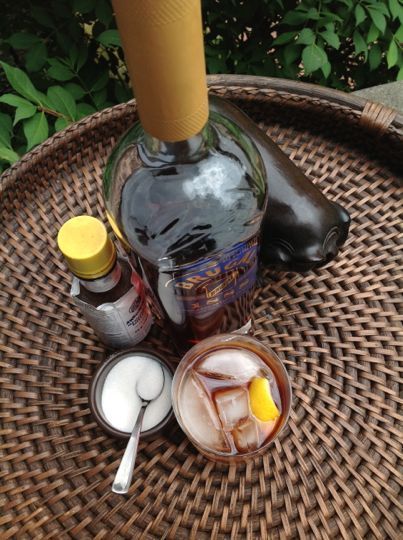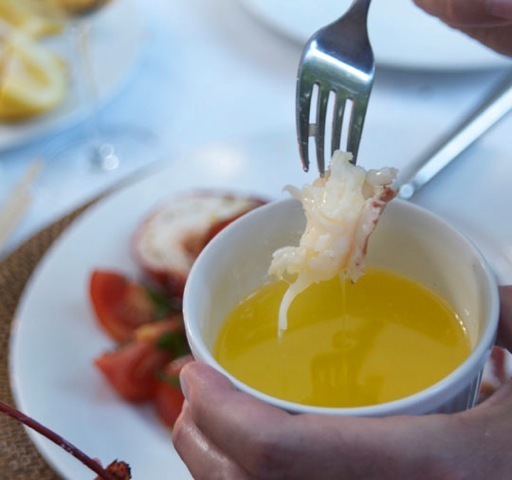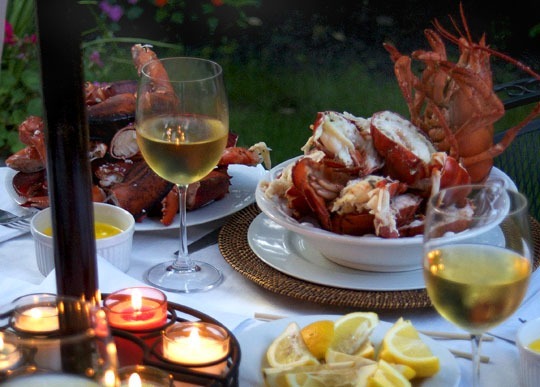Michael Ruhlman's Blog, page 38
August 7, 2013
Farmers’ Market Q&A with Forrest Pritchard

Forrest Pritchard at his honor system farm store.
Toward the end of Forrest Pritchard‘s memoir Gaining Ground, about his becoming a livestock farmer, he writes a chapter that I want to call attention to, and expand on, as we are now at the height of farmers’ markets, and this is in fact national farmers market week. I requested a Q&A to address continual questions he gets from friends and customers.
Forrest, why is food at the farmers’ market so expensive?!
On our farm, the food we raise reflects our true cost of organic production. When we set our prices, we do exactly what every other business in America does: we factor in our expenses, and establish a modest profit margin. That way, we’ll always be around to farm the following year. It’s Economics 101.
Everywhere we go, there’s a price-quality association in our culture: cars, houses, clothing. But for some reason, food operates independently of this reality. Dom Perignon aside, food is more or less food. Society has conditioned us to expect bargains when we enter the supermarket, placing price above freshness and quality. My free-range sausages might cost only a dollar more per pound, but for many people, it might as well be a million. When it comes to food, the price tag was where the story often begins and ends. But for someone trying to save his family’s farm, and do it sustainably, the conversation runs so much deeper than that.
So why isn’t the food at my grocery store similarly expensive?
Much of this food is already discounted, paid for in advance by government subsidies. Tax dollars—the same taxes that are taken out of all of our paychecks before we ever receive them—are used to partially pay for this food before it ever arrives at the supermarket. This “cheap” food is expensive, too. Unbeknownst to most of us, we’re simply purchasing it on an installment plan.
Then if I’m already subsidizing the food, I might as well finish paying at the grocery store, yes?
Sure. If you think a hamburger is just a hamburger, or that all apples are the same, then absolutely. But if you believe there’s a difference between a burger made from a single cow versus a burger made from a thousand cows, or apple juice squeezed from a local farm versus barrels of concentrate shipped from China . . . then the conversation becomes more complex.
Government policies hand out advantages to big farms that small farms can only dream of. The more corn and soybeans these big operation plant, the more tax money they can receive. Even crop insurance, money paid out in case of catastrophe, is subsidized. This reliable flow of cash gives owners confidence to build the infrastructure they need to support their operations, making these large farms hum with the highest modern efficiencies.
In the end, the owners of large farms are secure in the knowledge that huge sums of money are electronically transferring into their bank accounts while they sleep. They become the preferred partners of billion-dollar food companies, each with their own massive, nationwide processing and distribution centers. It’s all an economy of scale, and the scale is often gigantic.
Small farms like mine never have the economic firepower to match our larger counterparts. Our acreage is too small to adopt the efficiencies of big agriculture, and though we are entitled to subsidies as well, these payments are a pittance compared to what larger operations receive. As one secretary of agriculture famously proclaimed in the middle of the twentieth century, American farmers needed to either “get big, or get out.” By selling at farmers’ markets, and finding customers who truly valued the philosophies behind our sustainable practices, we were able to carve out just enough of a niche to save our seventh-generation family farm.
I don’t have time to shop at the farmers’ market, given when they’re open.
Understandable. Not everyone’s schedule can (or should) revolve around farmers’ markets. Fortunately, there are more options out there than ever.
For example, on our own farm I decided to create a 24-hour, self-service store. Folks drive in, take what they like, and drop their money in a little lockbox. It’s the ultimate win-win: customers are free to shop on their own schedule, and we run the store with minimal staffing, keeping our farmhands out in the field growing more great food. If our community truly wants to shop local, then we’re a year-round resource.
If your local farmer doesn’t have a storefront (certainly, not all farms do), then join a CSA (Community Supported Agriculture), a buying club, or a home-delivery service. Better yet, start your own garden, or participate in an urban farming plot. Presently, the opportunities for eating local and organic range far beyond simply shopping at farmers’ markets.
Any other questions you get tired of answering?
Despite penning a blog titled “4 Questions You Should Never Ask at Farmers’ Market,” I’m a firm believer that markets are the place where customers should expect to have all their questions answered. If I had a clicker at market, I would guess that on an average day I answer over 100 food/cooking/farming questions.
That’s a great post, Forrest, I hope people read it.
I never get tired of answering questions per se. But if I never get asked, “How can a hen lay eggs without a rooster?” again, then that would be fine with me. We all took sex ed, people. Don’t make your farmer blush.
Did you see the New York Times op-ed arguing that raising grass-fed beef was not sustainable, and that the only way to move forward is to drastically reduce consumption?
Yes, I always try to stay on top of what’s in the headlines when it comes to sustainable farming. The gist of the op-ed was that there’s not enough grass “out there” to replace the grain that we currently feed to confinement cattle, and as such, conventional production will continue in perpetuity. Cleverly, the writer cites no statistics whatsoever, so allow me to fill in the blanks.
In 2013, roughly 95 million acres of corn has been planted. Around 85% of this acreage will go to “animal feed,” destined for chickens, pigs, household pets (check the ingredient label on the bag, folks), and cattle. So, without knowing precisely how much acreage is devoted solely to grain-fed cattle, let’s safely assume that the number is less than 80 million acres. Currently, according to USDA surveys, there are over 600 million acres of underutilized pasture, range, and grassland. Stated another way, these aren’t pastures that are currently in use; rather, these are sustainable resources that are currently languishing.
So let’s break down the math: It takes 6.5 pounds of corn to make 1 pound of confinement beef and (on average) 2 acres of grass to finish one grass-fed steer each year. In 2011, the United States slaughtered 34 million grain-fed cattle, yet 600 million acres of pasture, divided by two, is 300 million potential grass-finished cattle. So my question is this: with over 10 times potential upside from a grass-finished production standpoint, what exactly is the point of this op-ed? I would respond by saying that we need more grass-farmers out there, plain and simple.
What’s your final message to people who buy fresh food?
Meet your farmer. Take a single hour out of your entire year, and visit the people who grow your food. When you see the farm, breathe the fresh air, and taste a tomato picked straight from the vine, concerns about price, quality, and time constraints quickly fall by the wayside.
This is something we can all value: healthy food, sustainable growing practices, and a living wage for our farmers. And the taste blows away anything you’ll get at the supermarket. So what are you waiting for? Go meet your farmers. They’ll be happy to see you.
If you liked this post, take a look at these links:
My past post on Farm Transparency v. Farm Secrecy.
Mark Bittman’s opinion article 11 Trillion Reasons to eat your vegetables.
Family Farm Defenders is a nonprofit organization supporting our family famers.
Looking for the closest farmers and farmers’ markets to you? Visit Local Harvest.
Civil Eats keeps up to date with all the politics in the American food system.
© 2013 Michael Ruhlman. Photo © 2013 Donna Turner Ruhlman. All rights reserved.
August 5, 2013
Dalton-Ruhlman Tools Price Reduction

The Dalton-Ruhlman essential kitchen tool bundle. Photo by Donna Turner Ruhlman.
When my old friend from high school, Mac Dalton, and I launched a small line of products in December 2010, I called it an experiment. The experiment worked, but not perfectly. The products, while of superlative quality, were nonetheless more expensive than we wanted them to be.
I’m thrilled to announce that we’ve now cleared a threshold that has allowed us to restock our warehouse in enough quantity to lower the prices to what we’ve always wanted them to be.
This means, for instance, that our beloved Badass Perforated (aka Egg) Spoon, which had been $33, is now $19.95. The big bundle of spoons and paddles (above), once $89 is now $59.95.
We hope you’ll have a look at the new catalog, tell friends via Facebook, let me know on Twitter, or, better still, leave subtle hints with loved ones who may be inclined to give you a gift (especially if you’re the one doing the cooking!).
We’re well aware that we have only gotten here because of the many who paid the high prices. To thank you all, those of you who chose to leave your email address, you’ll be receiving a code that will give you 25% off even these new prices for all purchases for the rest of the year.
Also, by request from chefs, we’ve created prices for bulk sales, especially useful for our offset spoons.
Again, many thanks to all. Never stop cooking!
If you liked this post, take a look at these links:
My past post on poaching an egg with the badass egg spoon.
Preorder my new hardcover The Book of Schmaltz, out next week!
Pioneer Woman shares a recipe for grilled peached & pecans.
© 2013 Michael Ruhlman. Photo © 2013 Donna Turner Ruhlman. All rights reserved.
August 2, 2013
Friday Cocktail Hour: Rum Old Fashioned

Rum Old Fashioned. Photo by me.
Taking up part-time residence in New York City last month, I was delighted to meet a downstairs neighbor, Tobin Ludwig, who makes the lovely Hella Bitters. What good karma for our new old building!
“What is your favorite use of bitters?” I asked. For someone who makes bitters, he struggled. I pushed. He relented and said, “A rum old fashioned.”
What a splendid idea, I thought.
Last night a tweet asked me for a cocktail with a good rum. And so there it was. The rum old-fashioned called. The weather has cooled, I have some most excellent rum, and the sweetness and the bitters combine for a great summer rum cocktail.
But lo—there was more, karma-wise. I returned to my original old-fashioned post and noticed that I’d used Hella bitters, long before I’d met Tobin! So this completes the circle, a cocktail destined for the Friday Cocktail Hour.
I suppose I’ll need to replenish my supply of Hella bitters!
Happy Friday all!
The Rum Old Fashioned
4 to 6 grams sugar (about 1 teaspoon)
4 to 6 grams bitters (about 1 teaspoon)
60 grams good rum (2 ounces)
Lemon
Place the sugar and bitters in a rocks glass and muddle and stir to get the sugar dissolving.
Add the rum and stir.
Add ice and a squeeze of lemon (or a twist or orange zest).
If you liked this post, take a look at these links:
My past posts that include rum are the Dark and Stormy, Man About Town, and Sour Cherry Daiquiri.
Try making your own rum at home.
Portside Distillery here in Cleveland makes various types of rums, and Cleveland Whiskey makes bourbon; small spirit companies are booming throughout the country.
Hemingway loved a great Mojito; learn what other writers enjoyed drinking.
© 2013 Michael Ruhlman. Photo © 2013 Donna Turner Ruhlman. All rights reserved.
August 1, 2013
Le Creuset Mini-Cocotte: Baked Eggs
Introducing the first of a new series of cooking videos on technique, though admittedly this one focuses on an actual Le Creuset piece, the cocotte. I love these little dishes. They’re great to cook in and great to serve in. I’m dying to do a little snail potpie in them.
In this video, though, I’m cooking my favorite ingredient, the egg. How many ways can this little miracle of nutrition and economy be brought to ethereal heights of soul-satisfying deliciousness? Enough to fill a book or ten (wait for mine, coming in April).
Here, I’m going with perhaps the easiest way of all to cook an egg, baked in an enclosed vessel. There are three different terms applied to eggs cooked in an oven. The second, after baked, is coddled: covered and baked in a water bath. (Some people I know use this term for a soft-boiled egg served in its shell, but I don’t.) The third is shirred: baked in a ramekin, uncovered. Each results in a slightly different egg.
I love the enclosure as the steam released by the egg remains trapped to gently help in the cooking. And of course the fun here is in the garnish, the different flavors you can use.
I’ll be back next week with another technique. See more of my technique videos here on the LC site. At the end of the video, btw, there’s a fun experiment LC is trying. I’m fascinated to see how it’s going to work. To enter, go here.
Coddled Egg with Many Variations
2 eggs per cocotte baked in an oven preheated to 325°F/163°C. Serve with toast.
For coddled eggs with cream and tarragon:
Crack the eggs into the cocotte, add 1 tablespoon cream and 1 teaspoon browned bread crumbs and bake just until the white is set, about 15 minutes. Sprinkle 1/2 teaspoon freshly minced tarragon on top and serve.
For coddled eggs with ham and cheese:
Put 1 ounce diced or thinly sliced ham into the cocotte (just enough to cover the bottom). Put the eggs in over the ham, cover with 1 tablespoon grated cheddar cheese and bake just until the white is set, about 15 minutes. Serve.
For coddled eggs with olive oil and Parmigiano-Reggiano:
Put 1 tablespoon olive oil into the cocotte, followed by the eggs. Cover with 1 tablespoon grated Parmigiano-Reggiano and bake just until the white is set, about 15 minutes. Serve.
If you liked this post, take a look at these links:
My other Le Creuset posts: Baking, Gratin, Roasting, Slow Cooking, Braising, and Grilling.
My Dalton-Ruhlman products.
A simple, fun, and easy egg recipe: . (Though I’ve got to say, it doesn’t get much easier than baking in a covered vessel.)
The Incredible Edible Egg shares information about this perfect little snack.
© 2013 Michael Ruhlman. Photo © 2013 Donna Turner Ruhlman. All rights reserved.
July 29, 2013
Turning 50 (with lobsters)

A birthday celebration done in style. Photo by Donna Turner Ruhlman.
All I wanted for my fiftieth birthday was to eat all the lobster I wanted, with a good white wine and a Blanton’s bourbon after.
I remember when my mom turned fifty because Donna insisted on doing something special for her, while I lamely lay in bed, scratching my head (within the hour she’d marshaled friends and chartered a plane to Key West for lunch).
My dad did a fifty-mile bike ride on his fiftieth with his girlfriend Pat; she was incensed by the arduous journey (“Rip,” she hissed, “you don’t need a woman, you need a machine,” to which he replied, “I just realized it’s my fiftieth birthday”).
They were so much older, fifty an impossibly remote age to me, a 25-year-old. Yet here I am now, on that very day. In a wistful column on aging rocker Mick Jagger and others, Gail Collins writes that Paul Simon, who’d penned the words in his youth, “how terribly strange to be seventy,” confirmed that while it wasn’t bad, it was indeed strange.
So, yes, strange to be fifty, as well. How did I get here? I’m still not sure but I do know it was only half intentional.
I got my first book contract when I was 30 (happily on my Dad’s 55th birthday).
I finished The Making of a Chef in 1997—that changed things for me. But not immediately. Donna and I were forever worrying about money. Broke, looking for a cook’s job summer of 1997, I went to an obscure restaurant in Bainbridge, OH, and walked out more or less with a plane ticket to The French Laundry in Yountville, CA.
I wrote The Soul of a Chef concurrently with The French Laundry Cookbook because I didn’t know what else to write; I wrote it so fast I was sure it was garbage and prayed no one would call me on it.
A chef-author I’d read, Anthony Bourdain, reviewed it for the New York Times Book Review. When I was in New York, I met him at his restaurant, then we met Eric Ripert at the bar Siberia, the original one, and drank beer, and the next day Eric and I flew to Puerto Rico for the winter installment of A Return to Cooking.
In 2003, after writing books about wooden boat builders and pediatric heart surgeons, I called my friend Brian Polcyn and asked if he wanted to help me write a book about Charcuterie, about animal fat and salt and preserving food. My daughter was now eight and my son four.
In the fall of 2006, I began this blog.
In the summer of 2009, not long after the iPhone was introduced, I gave into my compulsion to explore the idea that our fundamental preparations could be reduced to relative proportions and wrote Ratio. A year later, with the help of Will Turnage, I turned it into an app for smart phones.
The year after that, I published a book claiming there are only twenty things you need to know in order to cook just about anything. It won Beard and IACP awards, and as it was my first real collaboration with Donna, it is a book that remains enormously important to me.
A year ago, on a whim, Donna and I self-published a single-subject cookbook for iPads. We were going to do more, but I joined a new publisher who asked to publish the book in hardcover. The Book of Schmaltz will be out in a couple weeks.
I’ve got more books to write for Little, Brown. But I can’t help but wonder if I have anything relevant to say anymore. I probably don’t, nothing new anyway, but I can say the important stuff over again so nobody misses it.
This is important: since none of us knows when we’re going to die, the first rule of life is to have a good time. I would add a corollary: it’s important to have your Last Meal as frequently as possible (me: oysters, steak frites). And on my birthday, a year and a day after Donna’s, I want to have all the lobster I can eat.
I can lift a glass of this wonderful Riesling to Donna and thank her and tell her how lucky it is to be fifty.
If you liked this post, take a look at these links:
My recent post on pasta, asparagus, and an egg.
Learn more about lobsters at the Lobster Conservancy.
Rieslings are a perfect summer wine.
On oldie but goodie video of Bourdain and Ruhlman cooking in the kitchen together.
© 2013 Michael Ruhlman. Photo © 2013 Donna Turner Ruhlman. All rights reserved.
July 26, 2013
Friday Cocktail Hour: One More Gin and Tonic

Another gin and tonic, please. Photo by Donna Turner Ruhlman.
We are now in the full throes of summer, and there is no better cocktail to conclude a summer’s day than a gin and tonic. It is simplicity itself. It can be made extra-special if you use an excellent gin and, more importantly, an excellent tonic. But an inexpensive gin and some diet Schweppes will do the trick if that and a lime is all you have or want.
This is a seasonal drink. The bitter and bubbles refresh, the gin eases, and the citrus brightens. I like to use both lime and lemon, because lemon makes just about anything better and the bright color makes the glass more inviting.
If you want to simply enjoy a cooling cocktail at the end of a hot day, then I encourage economy over quality. But if you want to serve a really good gin and tonic, I believe it’s the tonic that stands out, accented by the gin. A tweet that came too late recommended Fever-Tree tonic, which my local grocer carries, but I went with the Fentimans because I like their ginger beer (used in the Moscow Mule).
I tried Broker’s gin on the advice of many tweeters as being a good but economical choice. I may well be a cretin, but I didn’t taste a difference between it and the even less expensive Seagram’s. For a high-end G&T, I’d choose the very piney Tanqueray, which has an aromatic punch equal to the tonic. Plymouth or Hendrick’s, I fear, would be steamrolled by a good tonic. If you want to feature the gin, use a light tonic, and a 1:1 or 1:1.5 ratio rather than the standard to-taste ratio.
After shooting the photo, Donna said, “I feel like it’s just now summer, but it’s already almost August.” Busy schedules, work, travel—and suddenly, yes, it is gone. Pay attention to the air. It’s so good now where we are. Take some time to enjoy your summer. And stay cool with a gin and tonic that fits your style.
Gin and Tonic
2 ounces gin
4 ounces tonic (or to taste)
squeeze of lime juice
squeeze of lemon juice (optional)
lime wedge
Pour the ingredients in a glass with ice cubes.
Stir well.
Garnish with the lime wedge.
If you liked this post, take a look at these links:
My past post that include gin are the Hasty Negroni, Boulevardier, Tom Collins, and classic Manhattan.
Pete Drinks is a blog that reviews many different types of beers, whiskeys, spirits, and drinking adventures.
A popular line of spirits is making its way out of Door County, Wisconsin—check out Death’s Door Spirits.
The Hour: A Cocktail Manifesto, by Bernard DeVoto, is a lovely meditation on that heavenly time of day.
© 2013 Michael Ruhlman. Photo © 2013 Donna Turner Ruhlman. All rights reserved.
July 22, 2013
Pasta, Asparagus, and an Egg
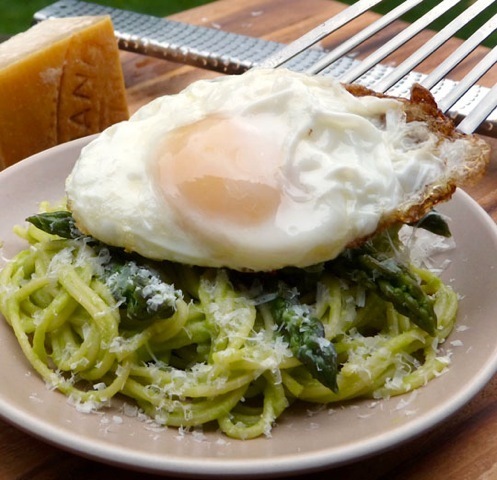
Pasta with asparagus and a fried egg. Photo by Donna Turner Ruhlman.
I was about 24 hours into my vegan experiment, planning to prepare pasta with asparagus and olive oil. In Ruhlman’s Twenty, I write about what a felicitous pairing scallops and asparagus are and make a sauce by pureeing the stems and mounting the puree with butter, serving the reheated tips as garnish. Finding myself with a good bunch of asparagus, I thought, “I’ll bet pureed asparagus makes an excellent sauce for pasta. But still it’s going to need a little oomph. Hmmm. Perhaps some freshly grated Parmigiano-Reggiano. Oops, not strictly vegan. But maybe just a few shaving, it’ll taste sooo much better.” I was hungry, and the dish needed a little extra something, which in so many instances is solved simply by adding an egg. Oh hell, why not mount a good deal of butter into that beautiful pureed asparagus and top the plate with a chicken’s egg.
Thus, my experiment in veganism came to a close with an absolutely fabulous, intensely asparagus-y pasta topped with more asparagus, cheese, and a fried egg. Worth every compromise. Looks like my own Ruhlman’s “twenty” will be sticking around for a while longer.
The following recipe will serve two full portions or four starter courses. The eggs can be poached rather than fried if you wish.
Pasta with Asparagus and an Egg
1.5 pounds asparagus, boiled till tender and shocked in ice water (save some of the cooking water)
2 ounces butter
Salt to taste
2 to 4 eggs
Vegetable oil for frying egg
Pasta as needed, 4 ounces dried per serving, cooked, oiled, kept warm
Parmigiano-Reggiano, to taste
Freshly ground black pepper
Cut off the asparagus tips, put them in a bowl, and cover with plastic wrap.
Cut the stems into 1-inch pieces and puree them in a blender, adding just enough of the reserved cooking water to get the puree going. Transfer the puree to a small saucepan. Bring to a simmer, then swirl in the butter, keeping it moving till the butter is completely incorporated. Add a four-finger pinch of salt. Keep warm.
Fry the eggs over high heat till the white is set, or cook as you wish.
While the eggs are cooking, reheat the asparagus tips in a microwave (you might want to toss with a little olive oil or butter first).
Toss however much pasta you feel like serving with the sauce till it’s evenly coated. Divide among plates. Grate cheese over each and top with the asparagus tips, followed by the egg.
Crack pepper over the eggs and serve.
Yield: 2 full portions or 4 starter courses
If you liked this post, take a look at these links:
My past post and video Guerrilla cooking demo—a weekday meal: Tomato Basil Pasta Using Tomato Water.
Learn how to grow your own asparagus for next year.
Here is a brief history of asparagus. Did you know that it is native to the eastern Mediterranean and Asia Minor areas?
Know the origin of your Parmesan cheese.
© 2013 Michael Ruhlman. Photo © 2013 Donna Turner Ruhlman. All rights reserved.
July 19, 2013
Friday Cocktail Hour: The Mojito Revisited
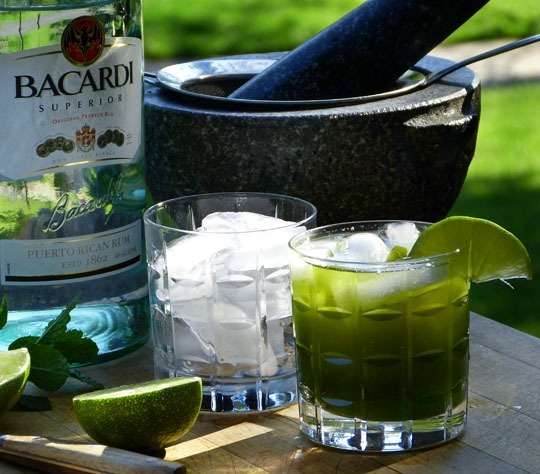
A great summertime drink, the Mojito. Photo by Donna Turner Ruhlman.
We’ve been on the road visiting our son at camp and have returned to the usual sea of email and backlog of work. So forgive me for reposting this classic, the Mojito. I’m not sure if everyone has seen the nightly news, but there are reports of a widespread heat wave. Just wanted to make sure you all knew. So if you’re in just about any place in the Lower 48, I definitely recommend preparing this cocktail in its traditional manner, in a highball glass, topped with soda water, plenty of it if temps are in the high nineties where you are.
Originally posted June 8, 2012
I’ve loved seeing the mutability of cocktails simply by changing the spirit during these Friday Cocktail Hour posts. This cocktail is in effect a mint julep made with rum, therefore called a Mojito. Of course what also distinguishes the Mojito from the julep is the lime juice and sugar, the intense sweet and sour. So, does that mean it’s like a whiskey sour with mint and rum? Yes, but no egg white. Or like a daiquiri without the mint? All of the above!
Regardless, this is a fabulous cocktail to make in the summer when the mint is taking over the garden and the heat calls out for a cooling rum drink. Again, I love the effect of the pulverized mint, the powerful minty flavor it brings to the sweet/sour lime, and the vivid, good-for-you greenness. Old school is simply to muddle the sugar and mint. I’ve never liked the scraps of mint floating dirtily in the clear rum, sticking inelegantly to the teeth. Even more reason to pulverize, grinding up the sugar along with it, and strain. Traditionally, club soda finishes the drink, but unless you intend to drink five of them, why dilute the goodness?
So, herewith, a modified version for the hale and hearty.
The Mighty Mojito
10 to 12 broad mint leaves
1 tablespoon/15 grams sugar
3 ounces/90 grams rum
Juice from half a lime (about 1 tablespoon/15 grams)
Wedge of lime for garnish (optional)
Combine the mint, sugar, and 1/2 ounce of the rum in a mortar and pulverize it with a pestle until the mint is a paste and the sugar is dissolved.
Add the remaining rum to the mortar and let it rest while you ready a lowball glass with ice.
Pour the lime over the ice. Strain the rum-mint-sugar over the ice. Press the mint in the strainer to squeeze out as much liquid as possible.
Garnish with lime wedges, if using.
Serves 1 (1 is just right, 2 is too many, 3, as I learned in New York with the mint julep, is never enough).
If you liked this post on making Mojitos, check out these other links:
My past posts with rum include the Dark and Stormy, Man About Town, and Sour Cherry Daiquiri.
Hemingway loved a great Mojito; learn what other writers enjoyed drinking.
Simon Ford shares where to drink cocktails when you are in Havana, Cuba.
Try making a refreshing cucumber lime mint agua fresca.
© 2012 Michael Ruhlman. Photo © 2013 Donna Turner Ruhlman. All rights reserved.
July 15, 2013
Summer Ceviche

A great summer treat, halibut ceviche. Photo by Donna Turner Ruhlman.
One of the lucky perks about being an independent writer is that I can occasionally entertain invitations to exotic locales on someone else’s dime. Not long ago I was asked by the Alaska Seafood Marketing Institute (institute! sounds academic, no? must be good for you) to visit Alaska. Several of the junkets were no longer available so I was clearly a last-minute fill-in invite. But this was not why I said no. It’s a busy summer is all (thus the 2 posts a week, and a repeat cocktail coming up). But the kind lady who invited me, one Christine Fanning, a senior communications specialist with Schiedermayer Alaska in Anchorage, asked if she could send me some of the finest fish coming off the Alaskan fishing boats. That, Christine, is good communications!
Sister Carri had brought me some exquisite rockfish from Alaska a while back, so no one needed to tell me how good the fish was from those waters. But I wasn’t going to tell Christine that. Now, what to do with the excellent halibut I received?
Halibut is the largest of the flat fishes, a lovely mild fish. It really just needs to be sautéed or roasted to serve warm. But it also makes a superb ceviche, “cooked” only with acidic citrus juice. Christine had been the one to suggest this, sending me a link to Rick Bayless‘s version for Alaskan halibut. I opted to include a sweet garnish (corn) and a fatty, luxurious one (avocado), some onion, and chives. Hard to go wrong when you have excellent fish.
My favorite halibut story comes from Thomas Keller, who, back in the late 1980s at Rakel, received a video from the purveyor, Ingrid Bengis, of the halibut she was sending being caught. So while Keller was serving this halibut, he put the video on the television (presumably by the bar, I didn’t ask). But it was an early effort from a chef to encourage diner awareness—uncommon at the time.
Halibut Ceviche with Corn and Lime
1 pound/455 grams halibut, cut into 1/2-inch dice
1/4 cup/25 grams minced red onion
Juice from 1 or 2 limes
2 teaspoons seeded minced jalapeño
1 avocado, cut into 1/2-inch dice
2 teaspoons minced chives
Kernels from 1 ear cooked corn
Sea salt
2 tablespoons extra-virgin olive oil, or to taste
Bread or crackers
Combine the halibut, onion, and lime juice just to cover and toss to combine. Let marinate for at least 10 minutes.
Add the chile, avocado, chives, and corn. Season with salt and add the olive oil.
Divide among 4 bowls and serve with crackers.
If you liked this post, take a look at these links:
My recent post on Wheat Berry Salad.
You can find a similar ceviche recipe in my award-winning book Ruhlman’s Twenty.
How to find the best ceviche in Peru.
Watch Anthony Bourdain and Eric Rupert nosh on ceviche in Peru.
© 2013 Michael Ruhlman. Photo © 2013 Donna Turner Ruhlman. All rights reserved.
July 12, 2013
Friday Cocktail Hour: La Paloma Revisited
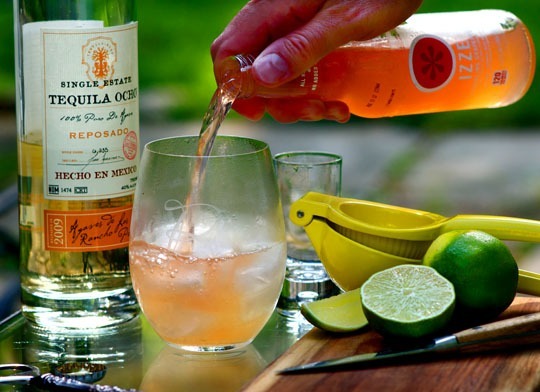
The refreshing Paloma: tequila, lime, grapefruit soda. Photo by Donna Turner Ruhlman.
This has become my favorite of Donna’s cocktail shots because it so accurately reflects the experience of drinking it. And as she’s on the road, playing hooky from her camera, I’m reposting this perfect summer cocktail. It’s dry and hot here in Clevelandtown, and these are seriously refreshing. Tequila, lime juice, and grapefruit soda. Couldn’t be simpler.
I love Tequila Ocho Reposado. Normally I save the good stuff for straight-up drinking, but it’s worth using in the Paloma because the lime and grapefruit flavors intermingle with and elevate, rather than obscure, the flavor of the tequila. And I make it strong, so I can taste it, goddammit.
Izze is excellent soda (not too sweet, lots of carbonation) and it’s what my grocery store carries. Jarritos is the brand most often recommended. But half grapefruit juice and half soda water works as well.
Have a most excellent weekend, all!
Paloma
3 ounces tequila
juice of 1/2 lime
3 ounces grapefruit soda, or to taste
1 wedge of lime for garnish, if you wish
Combine all of the ingredients in a beautiful glass filled with ice.
Swirl to combine.
If it’s very hot where you are, pause to consider you are about to indulge yourself with one of the most refreshing cocktails you’ve ever had.
If you liked this post on the Paloma, check out these other links:
My past cocktail posts on making margaritas, El Diablo, and sipping tequila,
Be a member of the Tequila Interchange Project.
Rick Bayless’s Frontera Grill in Chicago has some pretty stellar margaritas; here are some of his cocktail recipes.
© 2013 Michael Ruhlman. Photo © 2013 Donna Turner Ruhlman. All rights reserved.
Michael Ruhlman's Blog
- Michael Ruhlman's profile
- 354 followers



